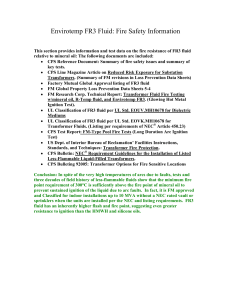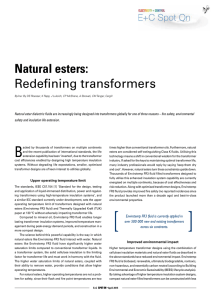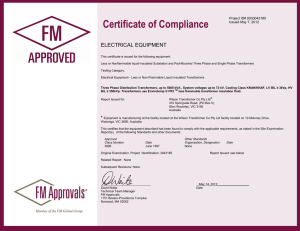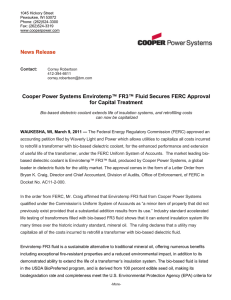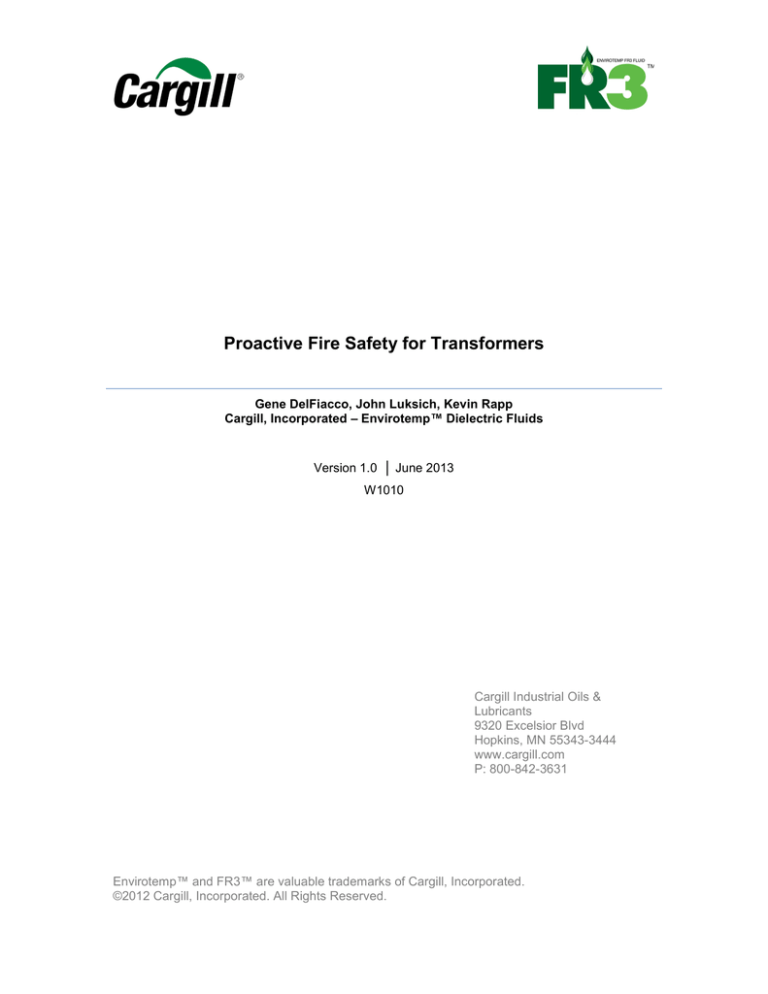
Proactive Fire Safety for Transformers
Gene DelFiacco, John Luksich, Kevin Rapp
Cargill, Incorporated – Envirotemp™ Dielectric Fluids
Version 1.0 │ June 2013
W1010
Cargill Industrial Oils &
Lubricants
9320 Excelsior Blvd
Hopkins, MN 55343-3444
www.cargill.com
P: 800-842-3631
Envirotemp™ and FR3™ are valuable trademarks of Cargill, Incorporated.
©2012 Cargill, Incorporated. All Rights Reserved.
Quantifying Risk of Transformer Failures
Proactive versus Reactive Risk Mitigation Approach
Prevent or react? Which would you rather be
in a position to do when it comes to
catastrophic (sustained) fires that develop
as a result of transformer failures?
If you’re like most people, prevention is the
preferable choice.
Today’s substation designers and asset
managers are proactively using field
proven technology to prevent catastrophic
incidents. In particular, they are specifying
and substituting less-flammable fluids
TM
TM
(Envirotemp FR3 fluid) in lieu of
traditional mineral oil dielectric coolant.
Conventional guidance offered by IEEE 979,
NFPA 850, or NFPA 851 which rely on
reactive systems (spatial separation, deluge
water spray systems, or fire walls) to
mitigate the spread of the eventual fire that
can develop during a mineral oil filled
transformer failure. By taking a
preventative approach by filling transformers
with less-flammable fluids such as
Envirotemp™ FR3™ fluid, utilities can
eliminate coping with long-term exposure to
risk.
Less-flammable dielectric fluids, typically
identified as those fluids having a fire point
above 300 ºC (572 ºF), reduce the likelihood
of a pool fire and fire propagation. Since
Envirotemp FR3 was introduced, there has
not been a reported failure resulting in a
pool fire for a transformer that was filled with
Envirotemp FR3.
Transformer Failure Modes
In order to understand how less-flammable
fluids reduce risk, one must understand
transformer failure modes and the physical
and chemical nature of the materials used in
manufacturing transformers.
The benefits of this proactive approach are
obvious as communities grow and people
live in closer proximity to older, installed
substation transformers.
Many transformers fail because their
insulation system is no longer able to
withstand stresses created during naturally
occurring events (such as lightning,
switching impulse, overloading, Ferro
resonance, secondary short circuit, line fault,
etc.)
An event such as those outlined above
causes the insulation system to experience
localized stress; the insulation system is
unable to withstand that stress, and a
breach occurs (typically somewhere in the
paper). From this breach, a (low or high
resistance) arc generates, and continues
until it is extinguished (either the source is
removed or the distance becomes so large
that the dielectric fluid quenches it).
Much depends on how long the arc survives.
During the life of the arc, much of the energy
associated with the arc (approximately 95%)
is consuming/destroying the materials
surrounding the arc. The remaining energy
is heating the surrounding materials.
For the dielectric fluid, this means the arc is
tearing apart the molecules, generating
combustible gases (acetylene for example)
at a substantial rate. As long as the arc
survives, pressure continues to quickly build
inside the transformer tank.
The rapid buildup of pressure and the ability
of the tank and components to withstand the
physical challenges being placed upon them
determine the potential impact of the
catastrophic failure. If the arc is
extinguished quickly, and the tank and
components withstand the pressure such
that no venting occurs, the transformer
simply stops operating. If however, the arc
is sustained, the pressure builds to a point
where the tank or components cannot
withstand the stress. The weakest part of
the tank will be compromised (i.e. a bushing
is dislodged, or a weld gives way, etc.) and
volatile gases will escape. Mixed with air
and an ignition source, the gases will
explode, causing substantial damage.
When this occurs, heat released from the
initial burning of combustible gases may
vaporize and burn a dielectric fluid that is
2
close to its flash point. If the heat of
combustion continues to vaporize the fluid, a
sustained fire on top of the liquid will result.
to 91°C is 1,160 MJ (the equivalent of a 100
MW fault lasting 580 cycles or about 10
seconds).
It is at this point that the characteristics of
the dielectric fluid become paramount.
Quantifying Risks
Consumer demand continues to force
increased loading of aged transformers.
Seasonal loading effects (summer loading
for A/C, storm severity, etc.) increase the
risk of transformer failure.
The predominant dielectric coolant is
mineral oil. Mineral oil, while exhibiting
reliable dielectric properties, typically does
not provide an adequate margin of fire
safety during transformer failure. Mineral oil,
with a fire point of approximately 155 ºC,
requires significantly less heat to bridge
normal operating temperatures outlined in
IEEE C57.91 to its fire point as compared
with less-flammable fluids like Envirotemp™
FR3™ fluid.
Thermodynamics of fluids
Analysis of typical transformer failure modes
shows that arcing under oil is the industry’s
most problematic failure mode. The arc is
very hot and contains a lot of energy. Here
is one unrealistic but noteworthy analysis of
the effect of arc energy on Envirotemp FR3
fluid:
-----------------------------------------------------Assumptions:
• A transformer has 30,000 L (≈ 8000
gal) of Envirotemp FR3 fluid.
• The oil temperature is 90°C
• 100% of the arc energy goes into
heating the fluid (realistically, less
than 5% of the arc energy goes into
heating the fluid, the remaining 95%
is producing combustible gases as
outlined above)
If 100% of the arc energy heated the fluid,
the amount of heat required to elevate the
temperature of 30,000 L of Envirotemp FR3
fluid just 1K to 91°C is 58 MJ. 58 MJ is the
equivalent of a 100MW fault lasting 29
cycles. In order to sustain combustion,
Envirotemp FR3 fluid temperature would
need to be elevated to over 300°C.
To make this analysis realistic requires
recalculating the fault energy based on less
than 5% of the arc energy heating the fluid,
i.e., the results calculated above must be
multiplied by 20. That is, the amount of heat
actually required to elevate the temperature
of 30,000 L of Envirotemp FR3 fluid just 1K
As our cities continue to grow, urban sprawl
is entangling older substation transformers.
With new substations likely to be located
closer to the population than in the past (as
space will continue to be at a premium), and
the use of underground substations
becoming more prevalent, the population is
exposed to an increasing potential for harm.
Given the average age of existing
transformer fleets, failures are occurring
more frequently, and industry experts expect
the rate of failures to continue to climb. The
probability of catastrophic failure increases
exponentially with the use of mineral oil as
the traditional dielectric fluid.
Financial Considerations
The historical technology and the traditional
approaches leave firms exposed to the
eventful failure and resulting costs
associated with repairing or replacing the
fire damaged infrastructure. Worse, in order
to have a favorable return on investment
(ROI is a typical financial go/no go decision
criteria), first investment cost must be
minimized; forcing consideration of true
owning costs over the life of the equipment
to be minimized (or ignored completely).
For example, normal accounting costs
associated with reactive approaches may
include:
• Site selection and preparation
• Substation design
• Purchase and installation of
transformer (and spare)
• Purchase and installation of fire
suppression equipment (deluge
system or fire wall)
• Infrastructure installation (cable,
protective relay systems, cable
towers, etc.)
• Insurance premiums
3
Other (long term) costs that may not
normally be accounted for include:
• Maintenance cost of fire mitigation
systems
• Rehabilitation of fire suppression
system and site conditions
(replacement of damaged
infrastructure; bus/cable, bracing,
pipes, towers, etc.)
• Emergency replacement costs of
transformers
- if used, unknown quality of
transformer
- if used, unknown insulation
life expectancy
• Lost revenue for longer than
required down time
• Site remediation of oil vented during
initial failure mode
CONCLUSIONS
History is focused on reacting to substationrelated events. Our industry is realizing that
there is affordable technology available
which helps minimize the long term risk
associated with catastrophic transformer
failures.
The analysis above indicates that
Envirotemp™ FR3™ fluid provides
increased margin of safety combined with
the flawless historical track record of lessflammable fluids making proactively
specifying (or retrofilling) substation
transformers with Envirotemp FR3 fluid the
best solution for mitigating risk associated
with transformer failures.
When total ownership costs are considered,
the small premium for less-flammable fluids
is easily justifiable. Risk mitigating
professionals understand and advocate the
use of less-flammable fluids in transformers
because it reduces their long term exposure
to damage and future insurance claims.
®
FM Global recognizes there is a significant
opportunity to mitigate catastrophic risk and
advocates the use of less-flammable fluids
in transformers, as indicated in their Loss
Prevention Data Sheets (for example, lessflammable fluids are even suitable
substitutes for costly deluge systems or
increased spatial separation distances,
resulting in a significantly reduced initial
investment, as well as long term
maintenance costs).
Additionally, the US National Electric Code
(NEC 450.23) recognizes that the probability
of a transformer fire occurring when filled
with less-flammable fluid is much lower than
when filled with mineral oil that it permits
indoor applications of less-flammable filled
transformers without requiring traditional fire
vaults.
4

